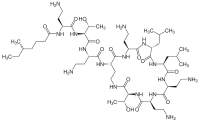
Photo from wikipedia
OBJECTIVES Resistance to polymyxins has been increasing in many regions and appropriate determination of polymyxin susceptibility is now a major challenge worldwide. Many clinical laboratories rely on gradient diffusion methods… Click to show full abstract
OBJECTIVES Resistance to polymyxins has been increasing in many regions and appropriate determination of polymyxin susceptibility is now a major challenge worldwide. Many clinical laboratories rely on gradient diffusion methods to assess polymyxin susceptibility, although broth microdilution (BMD) is the only method currently recommended by CLSI and EUCAST. The aim of this work was to assess the performance of polymyxin B (PMB) Etest® in a setting with high prevalence of KPC-producing K. pneumoniae. METHODS The commercial Etest® susceptibility testing method was evaluated and compared to the reference BMD, considering isolates with a minimal inhibitory concentration (MIC) ≤ 2 mg/L for PMB as susceptible to this drug. A total of 310 clinical isolates of KPC-producing K. pneumoniae were evaluated. RESULTS Susceptibility was significantly higher by Etest® compared with BMD (82.6% versus 75.8%, respectively). The MIC50, MIC90 and modal MICs for PMB were 0.25, 32 and 0.25 mg/L (27.1%) by BMD and 0.5, 16 and 0.5 mg/L (49.7%) by Etest® method, respectively. Although categorical agreement was 90%, there was a poor essential agreement (53.9%) between them. A high rate (34.7%) of very major error (VME) and a relatively low rate (2.1%) of major errors were found. CONCLUSIONS The considerable number of resistant isolates in this study allowed an accurate estimation of VME rates and, consequently, a more comprehensive assessment in susceptibility testing for polymyxins. Etest® did not meet fully acceptance criteria for the FDA requirements. Our data do not support the use of this commercial method for determining PMB MICs in carbapenem-resistant Enterobacterales populations.
Journal Title: Journal of global antimicrobial resistance
Year Published: 2020
Link to full text (if available)
Share on Social Media: Sign Up to like & get
recommendations!